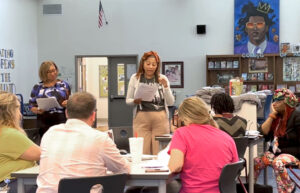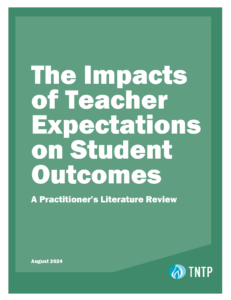Quarterbacks and teachers have at least one thing in common: they are leaders who guide teams to success in complex, unpredictable settings. But when it comes to performance feedback, quarterbacks—like virtually all high-performing athletes—have luxuries teachers can’t imagine.
At the elite level, after every practice and game, players and coaches review annotated films of their performance, noting strengths and weaknesses and creating detailed strategies to improve. It helps them improve their instincts and avoid mistakes.
Video has the same potential to transform education, especially because it is inexpensive and simple to use. But without the right approach, it may become just another gimmick: an on-screen instant replay without the kind of detailed feedback and analysis that can help teachers get better. The value isn’t in the technology – the value is in the intersection of technology and expertise.
We have been thinking about this at TNTP for quite some time. Today, we are expanding our use of video in multiple ways. For example, we’re using it enhance classroom observations in Tulsa through our Great Teaching, Great Feedback initiative and to judge entries for the Fishman Prize.
We have learned a few things about what it takes to make video worthwhile. Here are four quick thoughts:
- Use video to broaden the range of feedback a teacher receives. Video can connect teachers with the experts who can give them the best feedback, no matter where they are. For example, a building administrator without a background in science doesn’t have to fake it in a physics class; instead, she can have a great science teacher across town review a taped lesson and give feedback, without having to pay for a substitute or travel costs. If we don’t connect teachers with talent outside the building, we are missing the big magic.
- Create a dynamic replay experience. Good technology allows for time-stamped comments, which let us go back to the exact time in a lesson when something happened—or didn’t. By on-screen tagging, we can create play-by-play feedback that speaks to teachable moments, much like John Madden diagramming a replay on an NFL broadcast. (Boom!)
- Keep it real by making it routine. Like all observations, video observation and coaching is most helpful when we see the representative, not the rarified. Video observations can be done frequently with the flip of a switch, with almost no extra cost and minimal disruption. By making video a regular routine, teachers and students get past the impulse to play to the camera. That can let us see more of what everyday instruction looks like—and that’s where real teaching happens.
- Focus on a few key skills in each observation. Video can tempt us into overkill, over-analyzing every minute. We have to guard against replaying every interaction and swamping the teacher with “what-ifs.” Instead, we need to prioritize, focus and give concrete directions for how to do things differently. Video allows us to take one interaction in the classroom and propose specific alternatives. By grounding the suggestion in a recent experience and by getting specific, we can help teachers get better, faster.








